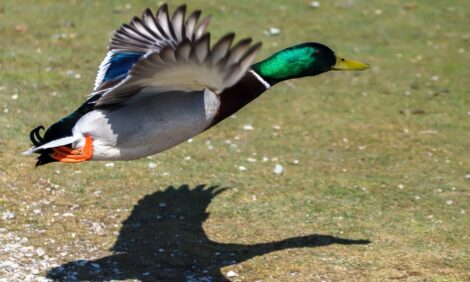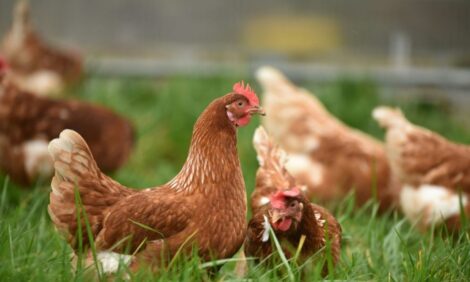



Competitiveness in the Supply Chain
By John H. Dyck and Kenneth E. Nelson. This is the second article in the series taken from the Economic Research Service's Structure of the Global Markets for Meat report. To read the other articles in this report, see the Further Sections table below.
Firms and, to some extent, countries compete to supply meat to consuming markets. Meat firms in an
exporting country compete both against domestic rivals and firms in the importing country. Success in this competition results in part from keeping prices low by minimizing supply costs. Producing and distributing meats involves several distinct phases from the farm and processing plant to the retail outlet, and each phase has necessary inputs. If the inputs are available at low cost, the final meat output can be offered at a low cost.
The meat supply chain starts with animal production at the farm level. Animals are next sold or transferred for slaughter and processing. Finally, there is a distribution process that takes the meat products to the final consumers. In the animal production stage, feed inputs are important (such as grass and forage for cattle and sheep, and grain and protein meals for swine, poultry, and fed cattle). Labor and equipment are also important to farm production of livestock (see
box, "Cost of Production for Hogs"). At the slaughter and processing stage, labor and equipment are important inputs (Hayenga et al.). Distribution also depends heavily on labor and equipment.
| Cost of Production for Hogs | ||
| Component | Cost (USD) | Share of total cost (%) |
| Feed costs | 20.36 | 32.85 |
| Feeder pigs | 16.63 | 26.83 |
| Veterinary/medicine | 1.10 | 1.77 |
| Fuel, lube, electricity | 1.32 | 2.13 |
| Labor costs | 8.38 | 13.52 |
| Marketing | 1.05 | |
| Hired labor | 2.39 | |
| Opportunity cost of unpaid labor | 5.03 | |
| Capital costs | 12.22 | 19.72 |
| Interest on operating capital | .70 | |
| Capital recovery of machinery/equipment | 10.74 | |
| Repairs | .78 | |
| Other costs | 1.97 | 3.18 |
| Total | 61.98 | 100.00 |
Recent U.S. data on the cost of producing hogs illustrate the major components of animal production costs. The costs are per hundred pounds of weight gain, for the year 2001.
|
||
| Source: Economic Research Service, USDA. http://www.ers.usda.gov/data/costsandreturns/testpick.htm | ||
Resources Used in Supplying Meat
Throughout the whole supply chain that brings meat to the consumer, the key inputs are feed, labor, and capital (both equipment and financial capital). The cost of feed inputs to a livestock farmer depends on the price of growing, processing, transporting, and storing the feeds. Feed costs will be lower for farmers close to major feed crop production areas because transportation costs will be lower. It is possible to ship grassbased fodders to cattle in farms around the world, but it is cheaper to let cattle graze directly on pastures, or to harvest forage crops and bring them to cattle that are being raised on the same farm. Feedgrains, such as corn, and oilseed meals, such as soymeal, can also be shipped, with or without being mixed into feed rations. However, the cost of shipping these bulky crops or feed rations can be minimized if swine, poultry, or grain-fed cattle are located near the crop areas.
Labor costs in the farming, slaughtering, processing, and distribution phases are an important part of the total costs of providing meat to consumers. Labor costs vary depending on the alternative ways that workers can earn money in an economy. An economy with a large nonagricultural sector tends to raise the wage expectations of prospective workers because many jobs are competing with jobs in livestock farming and meat industries. Similarly, if education levels are high and uniform, workers will have skills that will be demanded outside agriculture.
The presence and power of labor unions in farming and farm-related industries like meatpacking can also affect wages.
Capital is a key input in supplying meat. Increasingly, the meat processing and livestock production industries in developed countries have sought to reduce labor costs by replacing labor with machine-based systems. Farms for intensive livestock production require housing, efficient feeding and cleaning systems, environmental controls, and monitoring systems. The industrial nature of meat slaughter, processing, and distribution requires large capital investments. The ability to invest money in buildings and machinery requires access to financial capital, and investors seek to minimize the cost of the financial capital. Well-developed banking systems, insurance systems, and investment funds effectively lower the cost of financing the building and operation of meat processing plants.
Returns to size is an economic term that is applied if an increase in size of an enterprise results in lower costs and increased net returns (the difference between revenues and costs). There appear to be increasing returns to size at several levels of the meat supply chain. If large farm size can be achieved, then labor, capital, management, and other costs per unit can fall. Studies generally report size advantages gained from spreading capital costs over more animals as well as improved feed efficiency and labor utilization (Duncan et al.; Van Arsdall and Nelson). Given unchanged revenues per unit, lower costs result in increased net returns. If slaughter and processing plants achieve size economies and are well organized, costs per unit of meat will decline markedly (MacDonald et al.). Increasing the size of a firm may also lower distribution costs per unit of output. Meat operations and firms have an incentive to increase in size as long as such increases yield greater returns.
Regional Distribution of Resources for Meat Production
| Figure 1: Poultry feed prices in Japan and the United States | ||
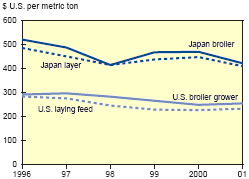 |
||
| Sources: MAFF (Japan) and NASS/USDA (United States). |
||
Spreading manure as soil nutrients on fields is the preferred method of disposing of wastes, but fields cannot absorb unlimited amounts of waste. Access to a large, nearby crop or pasture area reduces costs associated with waste disposal. In addition to the size and quality of land resources, population density on the land is increasingly pertinent to livestock operations. Densely populated areas sometimes restrict livestock farming and processing because of concerns about pollution.
Labor costs influence the location of meat production for export. Many developing countries have abundant, low-cost labor. This gives these countries a wage-rate advantage in livestock production and processing. Proximity of low-cost labor to major livestock production favors the development of export-oriented meat production. Brazil, where the production and export of poultry meat have flourished, benefits from the combination of large nearby feed production and relatively low-cost labor. However, other factors, such as animal disease standards, often intervene to prevent exports from developing countries. While wages in developed countries are higher, differences in labor market structure lead to significant differences in wage levels among developed countries (Figure 2).
| Figure 2: Monthly wages for "slaughtering, preparing, preserving," selected countries, 1998 |
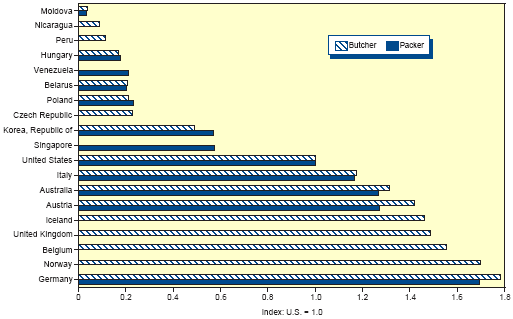 |
| Source: National Bureau of Economic Research, Occupational Wages around the World (OWW) Database http://www.nber.org/oww. Accessed April 11, 2002 (index by the authors). |
| Figure 3: Total meat exports by region (intraregional trade excluded) | ||
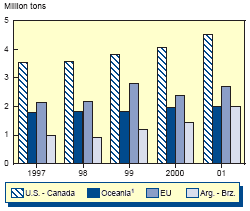 |
||
| 1Oceania is Australia and New Zealand. Sources: Volume data are from official trade data,and are on a product-weight basis, representing mostly boneless products. |
||
Geographic location works together with the basic resources of feed, labor, and capital to help determine where livestock industries will flourish. Having meat production near large numbers of consumers allows processing operations to realize economies of size and reduce distribution costs. Agreements on trade rules between countries can also expand the size of the market available to a firm, creating a multinational marketplace with common rules.
| Figure 4: Total meat imports by region (intraregional trade excluded) | ||
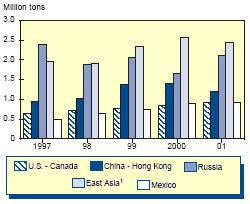 |
||
| 1East Asia is Japan, South Korea, and Taiwan, with trade within the region subtracted out. Sources: Data for China-Hong Kong are the sum of China's imports, less those from Hong Kong, and Hong Kong's imports, less those from China. Data for Russia are from official trade data and the USDA PS&D database (converted to a boneless basis for beef, pork, and sheepmeat by multiplying by 0.7). Volume data for United States-Canada, China-Hong Kong, and East Asia are from official trade data, and are on a productweight basis, representing mostly boneless products. |
||
Other major components of the current world meat trade also can be explained as the result of efficient use of abundant resources for animal production and processing (see Leuck for more discussion). The exporting regions of Oceania (Australia and New Zealand) and South America (Brazil and Argentina) use abundant land resources for animal production and export beef (Oceania and South America), sheepmeat (Oceania), and poultry meat (Brazil). Brazil, in addition to a large, productive crop agriculture and large pasture areas, also benefits from relatively low-cost labor and a large domestic market.
East Asia—defined as Japan, South Korea, and Taiwan—is usually the world’s largest meat-importing region (fig. 4). The region is densely populated, with mountains and forests that limit the land available for agriculture, so that large-scale feed production is relatively expensive. Furthermore, the region has relatively high labor costs. East Asian livestock producers must pay to import feeds, and locating large-scale farms and processing plants is sometimes difficult because of pollution concerns and land costs. Although East Asia’s meat producers benefit from proximity to a large domestic and regional market, the region as a whole has become a major meat-importing zone.
Source: U.S. Department of Agriculture, Economic Research Service - September, 2003







